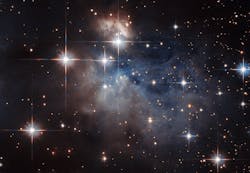IMAGE: Showcased at the center of this NASA/ESA Hubble Space Telescope image is an emission-line star known as IRAS 12196-6300. This star displays prominent emission lines that, when compared to the "fingerprints" left by particular atoms and molecules, can be used to reveal IRAS 12196-6300's chemical composition. This is just some of the groundbreaking work being done by the Hubble Space Telescope. (Image credit: ESA/Hubble & NASA; acknowledgement: Judy Schmidt)
The National Aeronautics and Space Administration (NASA) is contractually extending science operations for its Hubble Space Telescope an additional five years. The agency awarded a sole source contract extension to the Association of Universities for Research in Astronomy for continued Hubble science operations support at the Space Telescope Science Institute in Baltimore, MD.
RELATED ARTICLE: Hubble spectrograph pinpoints source of Milky Way's Magellanic Stream
This action will extend the period of performance from July 1, 2016 through June 30, 2021. The contract value will increase by approximately $196.3 million for a total contract value of $2.03 billion.
The contract extension covers the work necessary to continue the science program of the Hubble mission by the Space Telescope Science Institute. The support includes the products and services required to execute science system engineering, science ground system development, science operations, science research, grants management and public outreach support for Hubble and data archive support for missions in the Mikulski Archive for Space Telescopes.
After the final space shuttle servicing mission to the telescope in 2009, Hubble is better than ever. Hubble is expected to continue to provide valuable data into the 2020s, securing its place in history as an outstanding general purpose observatory in areas ranging from our solar system to the distant universe.
In 2018, NASA's James Webb Space Telescope (JWST) will be launched into space as the premier observatory of the next decade, serving astronomers worldwide to build on Hubble’s legacy of discoveries and help unlock some of the biggest mysteries of the universe.
SOURCE: NASA; http://www.nasa.gov/press-release/nasa-extends-hubble-space-telescope-science-operations-contract
